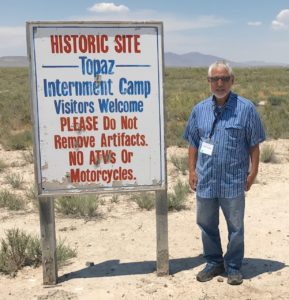From Japanese-American Internment Camps to the Muslim Ban: The Terrible Consequences of Discriminatory Executive Orders
THE TORCH: CONTENTSBy John Yuasa
JULY 27, 2017
“An Executive Order put my family in a Concentration Camp.” That was the sign I carried as I joined thousands of other people at Los Angeles International Airport to protest the executive order of Jan. 27, 2017, that initiated the Trump administration’s Muslim ban.
Let me explain. In February 1942, President Franklin Roosevelt issued Executive Order 9066, which authorized the removal and incarceration of 120,000 people of Japanese ancestry living on the West Coast. People had just a few days to prepare and were permitted to bring only what they could carry. Many families suffered crushing economic losses as they hurriedly sold their farms, homes, and businesses.
At that time, my California-born U.S. citizen parents were expecting their first child—me. My parents, who lived in Oakland, were sent to the Tanforan Assembly Center, a converted racetrack that had about 180 barracks, located just south of San Francisco. Twenty-six of the buildings were converted horse stalls, with cardboard installed in the upper portion of the walls between the stalls. There was no privacy between the families that were living in each stall. The barracks were filthy and fetid—filled with horse flies, fleas, and dried manure and urine smells. Tanforan was surrounded by a barbed wire fence, with armed military police on guard.
Once I was born and able to travel, we were taken by train to the Topaz “Relocation Center,” more accurately described as a prison camp. Topaz held more than 8,000 people in approximately one square mile of land. It was located about 100 miles southwest of Salt Lake City, in an arid desert that varied from over 100 degrees in the summer to below zero in the winter. Strong winds blew sand everywhere, including into the living quarters and everyone’s food. The crudely constructed barracks provided little protection against the extreme weather. The camp was patrolled by 85 to 150 soldiers and was also surrounded by a barbed wire fence. Manned watchtowers with searchlights were placed every quarter mile around the perimeter of the camp.
I had never been back to that site of my infant incarceration, but the recent grand opening of the Topaz Museum, in Delta, Utah, offered me a reason to return. The ceremonies that took place reminded all of us what it is to be free and how hatred, prejudice, and discrimination can enable a government to incarcerate people who have committed no crimes, without any opportunity for legal due process.
In 1942, the government’s position was that national security required this policy on internment. However, in 1982, the Commission on Wartime Relocation and Internment of Civilians issued its report, which documented a far different reason. In its specific findings and recommendations, it states that the broad historical causes were “race prejudice, war hysteria and a failure of political leadership.”
Now, for no other reasons than prejudice, national security hysteria, and a failure of political leadership, the president has decided that people attempting to escape persecution by coming to the United States present a national security risk—solely for being Muslim. We cannot allow this unconstitutional order to stand. Please join me in being an active participant in our democratic process to ensure that our laws and regulations against discrimination are enforced and, where necessary, strengthened.
John Yuasa is a former Peace Corps volunteer, deputy director of the Office of Federal Contract Compliance in the Department of Labor, and nonprofit executive.






